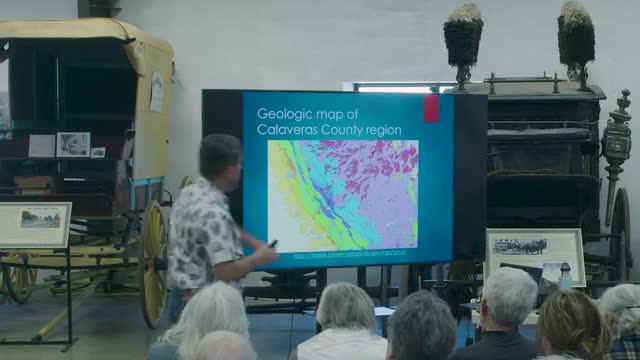Geologists explore Sierra Nevada's tectonic activity and rock metamorphosis processes
March 10, 2025 | Calaveras County, California
This article was created by AI summarizing key points discussed. AI makes mistakes, so for full details and context, please refer to the video of the full meeting. Please report any errors so we can fix them. Report an error »

The government meeting held on March 10, 2025, in Calaveras County, California, focused on the geological history of the region, emphasizing the transformation of seafloor sediments into the diverse rock formations present today. The discussion began with an overview of the geological processes that have shaped the area over the past 400 million years.
The speaker detailed the origins of the Sierra Nevada's granitic rocks, which formed deep beneath the Earth's surface and were later exposed through erosion. This ongoing process of uplift and erosion continues to influence the landscape. The meeting highlighted the movement of tectonic plates, particularly the Farallon plate, which has played a crucial role in the geological evolution of North America. As the North American plate moves westward, it collides with the Farallon plate, leading to subduction and the addition of sediments to the continent's edge.
The speaker explained the process of accretion, where seafloor sediments, originally mud, undergo metamorphosis due to heat and pressure, transforming into various rock types such as shale, phyllite, and greenstone. The discussion included the formation of limestone from marine organisms, which later metamorphosed into marble. These geological changes have resulted in the diverse rock formations found in Calaveras County today.
Additionally, the meeting addressed the role of volcanic activity in shaping the region's geology. The speaker described how magma generated from subducted materials contributes to the formation of granite and other volcanic rocks. The discussion also touched on the presence of gold within these geological formations, explaining how tectonic activity and volcanic processes have concentrated gold deposits, making them economically viable for extraction.
In conclusion, the meeting provided a comprehensive overview of the geological history of Calaveras County, illustrating the complex interplay of tectonic movements, sedimentation, and volcanic activity that has shaped the region over millions of years. The insights shared during the meeting underscore the importance of understanding local geology, not only for its scientific value but also for its implications in resource management and economic development.
The speaker detailed the origins of the Sierra Nevada's granitic rocks, which formed deep beneath the Earth's surface and were later exposed through erosion. This ongoing process of uplift and erosion continues to influence the landscape. The meeting highlighted the movement of tectonic plates, particularly the Farallon plate, which has played a crucial role in the geological evolution of North America. As the North American plate moves westward, it collides with the Farallon plate, leading to subduction and the addition of sediments to the continent's edge.
The speaker explained the process of accretion, where seafloor sediments, originally mud, undergo metamorphosis due to heat and pressure, transforming into various rock types such as shale, phyllite, and greenstone. The discussion included the formation of limestone from marine organisms, which later metamorphosed into marble. These geological changes have resulted in the diverse rock formations found in Calaveras County today.
Additionally, the meeting addressed the role of volcanic activity in shaping the region's geology. The speaker described how magma generated from subducted materials contributes to the formation of granite and other volcanic rocks. The discussion also touched on the presence of gold within these geological formations, explaining how tectonic activity and volcanic processes have concentrated gold deposits, making them economically viable for extraction.
In conclusion, the meeting provided a comprehensive overview of the geological history of Calaveras County, illustrating the complex interplay of tectonic movements, sedimentation, and volcanic activity that has shaped the region over millions of years. The insights shared during the meeting underscore the importance of understanding local geology, not only for its scientific value but also for its implications in resource management and economic development.
View full meeting
This article is based on a recent meeting—watch the full video and explore the complete transcript for deeper insights into the discussion.
View full meeting
